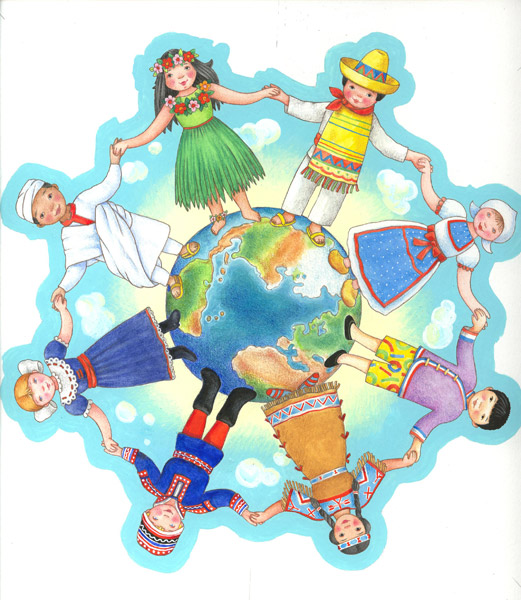Summary
Students will recognize and describe the different cultures within their community.
Essential Question(s)
How are the cultures within my community alike and different?
Snapshot
Engage- Using the Elbow Partner strategy, students will identify and write down their similarities and differences on a Venn Diagram chart.
Explore- Students are divided into small groups. As a group, they read and discuss the book assigned to them.
Explain- Students write one sentence about their culture on a sticky note and share their recording by taping it on the Melting Pot Class Chart.
Extend- Students present an important item that represents their culture.
Evaluate- Students will create a piece of art that represents their culture.
Materials
Similarities and Differences Venn Diagram
Books
- Clothing of the World by Nancy Loewen and Paula Skelley
- Food of the World by Nancy Loewen and Paula Skelley
- People of the World by Nancy Loewen and Paula Skelley
- Homes of the World by Nancy Loewen and Paula Skelley
Melting Pot Class Chart
Variety of craft materials such as feathers, beads, pipe cleaners, colored construction paper or card stock, paper plates, paper cups, paint, pom poms, colored pencils, glitter, etc.
Engage
25 Minute(s)
Using the Elbow Partner strategy, students analyze their similarities and differences between them. They write their findings on the Similarities and Differences Venn Diagram.
You may need to guide and encourage students' interest by asking a variety of questions such as:
What do you notice about your partner?
What color are his/her eyes?
Are you both the same height? Different?
Do you have questions or wonderings?
Students present their similarities and differences to their class.
Mini Practice: Have students go home and ask their parents to share with them more about their culture. If possible, have them bring a special item that represents their culture. Examples might be coins, pieces of clothing, jewelry, pictures, pottery, etc. This will be used later on in the lesson.
Explore
45 Minute(s)
Students are divided into small groups. They are assigned a book to read as a group, discuss, and pay attention to the pictures presented in the book. A list of possible books is: Clothing of the World, Food of the World, People of the World, and Homes of the World by Nancy Loewen and Paula Skelley. Depending in the diversity of your classroom you might use the “Lakeshore Children of the World Book Set.”
Guide the students to create an "I notice, I wonder" chart. They divide a piece of paper into two equal parts by folding it in half. At the top of one column they write "I notice." Here they write what they notice about the cultures presented in the book they read and discussed. At the top of the other column, they write "I Wonder." Here they write their wonderings and questions about what they read and discussed. Finally, using the Elbow Partner Strategy, students share with their classmates what they recorded on their charts.
Mini Practice: Have students share if any of the information they read in the book or any information their classmates shared represents their culture. Have them talk about what they thought it was interesting to them.
Explain
30 Minute(s)
Create the Melting Pot Chart before class. On a post-it sheet or chart paper, write Melting Pot in the middle of the chart. Draw a picture of a melting pot right under the title. This chart will be displayed somewhere in the classroom.
Using the Quick Draw Strategy, students will draw an important representation of their culture on a sticky note. For example, they might want to draw a piece of clothing, favorite food, a symbol, their country flag, etc. Once they are done doing this, they tape it on the Melting Pot Chart you have created before class. Then, students will take turns sharing with their class about their drawing.
Mini Practice: Have students return to their "I Notice, I wonder" charts and add any new information.
Extend
45 Minute(s)
Students were assigned earlier in the lesson to go home and ask their parents to share more about their own culture with them. Begin this part of the lesson by having the students share what they know about their own culture with their classmates. If they brought a special item that represents their culture, have them tell their class about it. Some of the guided questions might be:
Why is this item important/special to your family?
What part of your culture does it represent?
What is the history behind it?
Do you have questions or wonderings?
Students have to be very careful since these might be considered family treasures. These pieces can be displayed on a table in the classroom for everyone to see.
Evaluate
45 Minute(s)
Have students return to their "I Notice, I Wonder" T-Charts. Ask students to check their charts to see whether or not their questions have been answered. If not, then this is a great time to have them search the answers to their questions on Kiddle.
Students will use all materials provided to create a piece of art that represents their culture. These artifacts could be be a piece clothing, sculpture, flags, their native country map, jewelry, etc.
Differentiation for Gifted Learners
25 Minute(s)
Students can be challenged by creating a puppet of the country they’re most interested in. They may work individually or in groups. If time allows, have them present their final product to their classmates.
Resources
K20 Center. (n.d.) Elbow Partners. Strategies. https://learn.k20center.ou.edu/strategy/116
K20 Center. (n.d.). I Notice, I Wonder. Strategies. https://learn.k20center.ou.edu/strategy/180


